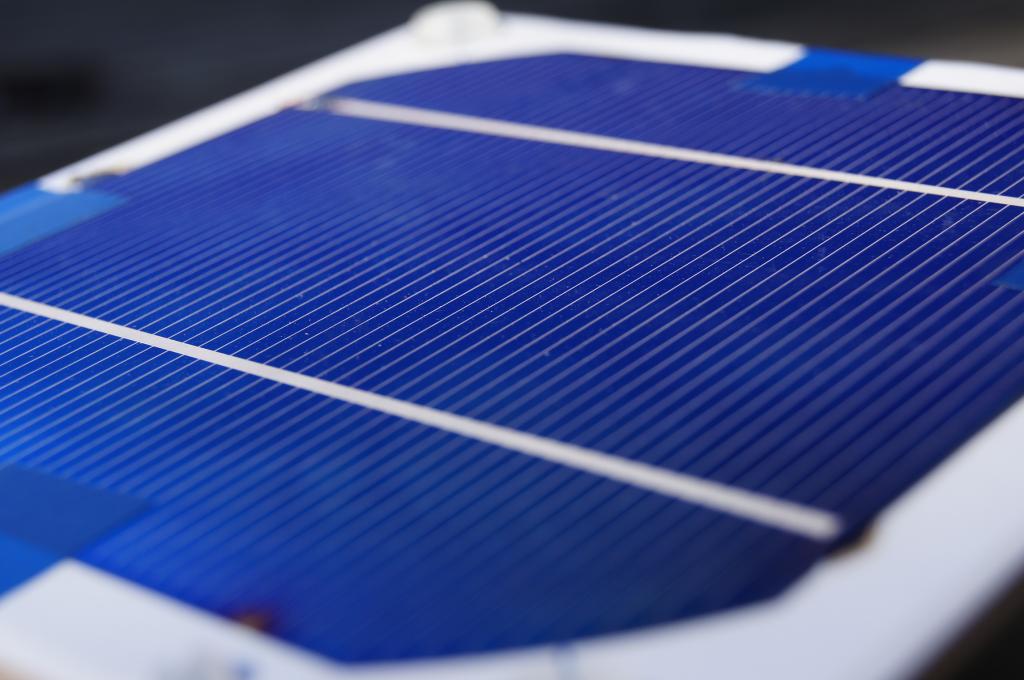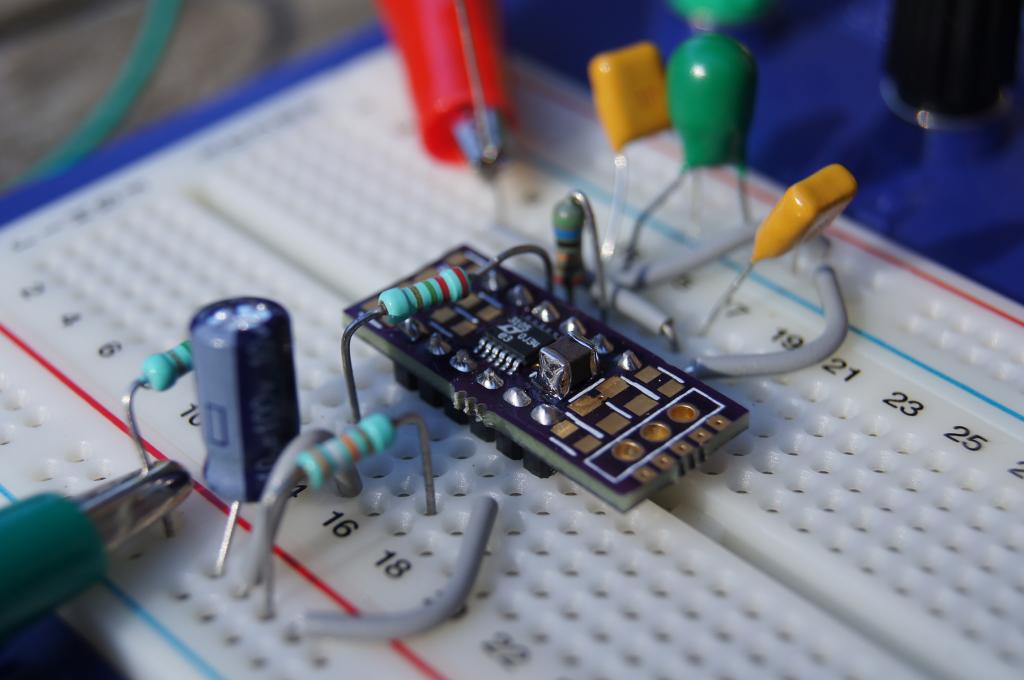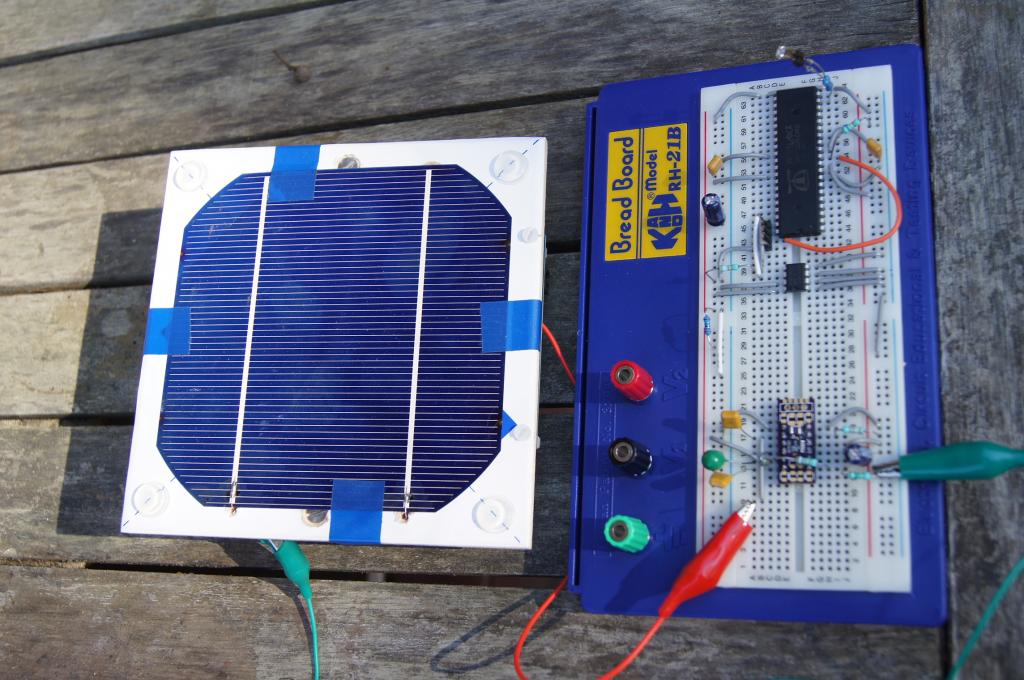Booting the Prop from low voltages, 1 of 3: Single Solar Cell @ 0.56V
 Tubular
Posts: 4,767
Tubular
Posts: 4,767
Finally had a chance to fire up my low voltage booster based on the LTC3105.
The LTC3105 is a 'solar energy harvester' that features maximum power point tracking, has low quiescent current, and a switch rated at 400mA.
It can start up from voltages as low as 0.25V, which makes Parallax's single solar cell a good match not only when its sunny, but also when overcast, and even indoors with a bit of window light.
This successful test was completed in dappled sunlight with the single cell producing 0.56v, an output setpoint ~ 3.2v, booting the prop and flashing a led.
LTC3105 links:
Video
Datasheet
The LTC3105 is a 'solar energy harvester' that features maximum power point tracking, has low quiescent current, and a switch rated at 400mA.
It can start up from voltages as low as 0.25V, which makes Parallax's single solar cell a good match not only when its sunny, but also when overcast, and even indoors with a bit of window light.
This successful test was completed in dappled sunlight with the single cell producing 0.56v, an output setpoint ~ 3.2v, booting the prop and flashing a led.
LTC3105 links:
Video
Datasheet





Comments
I'll have to check out the LTC3105.
Bean
http://www.aldinc.com/ald_energyharvesting.htm
I tested it with my bench supply, powering a PIC board flashing an LED, but that only goes down to 1.25V; I should have used have used a pot for a proper test. I've got a solar cell somewhere that I could try.
My question, and perhaps you could test this, is if you feed it say 0.6 volts forever, does it ever manage to reach its 3.6v target and switch on its output? Or does its internal storage just stay at 0.6 volts waiting for a higher voltage to advance...
One thing about solar panels is that if you use the standard circuit with a reverse protection diode, with say 36, or 10 or whatever number of solar cells, one of your cells is wasted with the voltage drop in the diode.
But with one solar cell, there is no wastage. And with single solar cells, you can parallel them up to as many as you like. I've picked up broken solar cells in the past for great prices, but one problem with putting broken cells in series is that the total output amps is limited by the worst cell in the group. But put single cells in parallel, and nothing is wasted - the amps just add together.
The spec sheets also mention thermoelectric generation. Grab a peltier device, hook it up as a thermoelectric generator and run your prop from warm water?
For example:
Case1: I have a solar powered prop application and it's a nice sunny day, the prop can check its power source and spin off all its cogs and functions without worrying about a brown-out.
Case2: It's a partly cloudy day, I'm at 50-75% of power output on my solar cells. I can run most functions but a few things my prop does may not be started/running. The prop application is functioning with diminished capacity.
Case3: Cloudy/Indoor, I'm at less than 50% power output. Start up one cog to run minimal housekeeping and application functions. Check the power every so often to see if the situation is improving.
Case4: Go to sleep to wait for more light. minimum power usage, waiting on a pin for a signal from the power harvester.
You could tailor your code/application to provide functionality based on the power being harvested.
That ought to be possible. I think you need a voltage reference - something that in itself uses minimal power and always outputs the same voltage. If the prop measures that voltage (say it is 1V, or 0.1V - it does not matter), it can compare this with the solar cell output. Put a large capacitor in parallel with the solar cell(s). Presumably it is running Case3. Now load it up a bit more and see if the solar cell volts drop too much. The capacitor adds a delay so there would be a few seconds to do this. Input still stable at say, >400mV? Then load it up a bit more.
I see some cool experiments ahead...
Leon, the very same data sheet tells me its min charging voltage is 4.0 volts, which would be consistent with a "managed supercap" arrangement, rather than some kind of charge pump that is able to boost 0.6v to 3v3. When its storage cap is fully depleted I don't doubt that it starts charging from 0v!
ALD make some nice parts, but that is certainly not the clearest datasheet I've ever read. Block diagram? Efficiency curves or even typical values?
The LTC3105 has an open drain 'power good' signal which floats up to whatever rail you tie its resistor to, once the main output hits its preset value determined by its feedback resistors. This can be used to release the prop from reset for example. The datasheet also shows a way to LTC3105 to go back into shutdown (thus preserving what is left in the reservoir for the next cycle..)
That shunt regulator is a nice solution to the 4mA limit. I actually started with the LTC3108 (here) , then moved on to the LTC3105 for more current and the MPPT feature. The LTC3108 is amazing, starting off such a low voltage as it does.
Also those LPR6235 coupled inductors (transformers) are great for several applications.
They can be had for $2 from Coles or Woollies and include a 500mA rechargable AA battery. On my boat, I replace the LED with a superbright blue LED, and replace the battery with a 2500mA one. They then run for the whole night for about 3 weeks, at which time I recharge the battery manually (tops it back up).
The '3105 seems to be a much better match for a solar cell and for extracting a lot more power. (relatively and maximally speaking!)
It may also be possible to break up Parallax's huge cell and get multiple cells out (at lower currents!). Mine already has a small crack across one corner, perhaps I should help it along
Tracy what kind of voltage do you get from your TEG with a 7 degree difference? I am thinking about adding a TEG to give at least some kind of gradual power source for when the solar panel gets covered with dust / grain.
I ´m interested by your small board with the LTC3105, you use in your experimentation.
If you can tell me where you buy, I search this kind of board since 3 weeks and nothing
only one board for evaluation and it ´ s huge. I search something small .
Thanks
stongej
To Tubular, and you as well, Tracy.
Where did your completely amazing boards come from? I've got about six different ideas taking shape, and two of them involve running a Prop off of a solar cell array.
Anyway, it's very interesting and matches something I've had in my mind for some time. Glad I found the thread, even though it's old.
Anyway, I collected some current links:
LTC3105fa data sheet Updated Linear link (the 404 from post #1, new location)
LTC3105p data sheet
Various Linear LTC3xxx chips
-Tor
That'll work. Please keep us posted.
They show one of their redbots, (A bot powered by an Arduino clone of their making.) wearing a big cell of their design on its back.
Now I'm curious if this individual https://www.sparkfun.com/products/9946 can be confused into running say the Prop version of the BOE bot, or its relative the Activity Bot. (Its possible they are the same gizmo, but the company does sell a Prop version of the BOE set.)
Now that would be interesting, and throw a big heap of stuff at the Arduino robot builders.
EDIT: It turns out that the bot shown in the learn portion of their site has since retired from normal lists. They do not list a replacement.
Looking around, I found these breakouts for the LTC3108 and LTC3105.
https://forum.crispytronics.com/.
Buck, I tried your signature link but it timed out. Send me an email at tracy@emesystems.com and I'll hook you up with one of my boards. The connections on the edge are for the power, status and control. You'll have to swap the 0603 resistors if you want to change the output voltage and MPPC point.
Okay I'm writing one now. Don't know why the site was ignoring you. And thank you in advance.
Tracy, this is exactly what I was wanting to do about a year ago. What are you using for a TEG? I will have low temperature differences as well.
The output is minuscule at low temperature differentials. I'm attaching a graph of voltage output vs temperature difference and another of the milliamp output of an LTC3108. The output impedance of a TEG is very low, around 1 ohm. You can see that the '3108 with the 50:1 xfmr kicks in at around 0.1V, and that requires a temperature differential of about 20°C. The circuit maxes out at 4mA, around 1 volt from the TEG or 40°C from hot to cold side.
For comparison, I also attached a graph showing much higher temperatures produced by a rocket stove. Around 120°C it is producing more that 3 volts and 4 watts into a 2.4 ohm load.
Solar cells have a surprisingly (or maybe not) flat voltage output in their useful range. Obviously brownout detection becomes important though.
I came across the opposite problem not long ago where people were discussing trying to wire up a small array of solar panels directly to a hot water heater. Problem here is, to heat the water you are wanting to extract peak power as much as possible. Because the light levels vary so much a straight resistive load like that will be very inefficient without a switch-mode (MPPT) converter.
Hello!
Tubular can you point me towards your schematic after the converter? That is everything the Prop needs to operate. Oh and the program you wrote also.
Tracy, the board, plus your document arrived today. It must have ran all the way here from your neighborhood. Now the interesting thing will be in convincing a Prop on a Quickstart board to blink one LED at me so I can work with your widget...
CON _clkmode = RCSLOW MYLED = 16 ' one of the blue leds on the quickstart PUB Blink outa[0..27]~ ' all pins start as low outputs to minimize Iq dira[0..27]~~ repeat outa[MYLED] := 1 ' high for about 400 clock ticks, 20ms at 20kHz outa[MYLED] := 0 waitcnt(40000+cnt) ' 2 second waitTracy, neat graphs. 7 degree delta T minimum is interesting. I've often wondered whether putting a TEG (or stack of two?) on an external door (with metal liners) would generate enough power via temperature difference to be able to tweet the door open/closed status. That's starting to sound plausible with the 3109
micro-power experiments with the propeller.